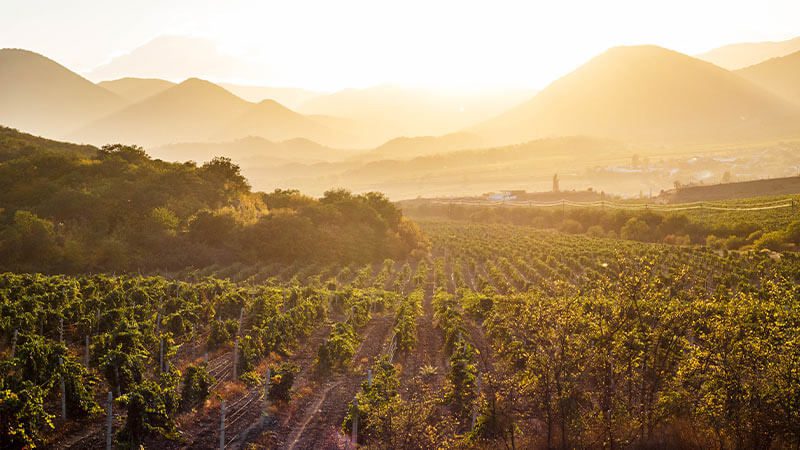June 20, 2024
Unpacking the Unique Characteristics of Barossa Shiraz

The Barossa Valley, located in South Australia, is one of the world's most renowned wine regions, and at its heart lies the iconic Barossa Shiraz. This wine, known for its bold flavours, rich history, and distinctive characteristics, has captivated wine enthusiasts and critics alike. To fully appreciate Barossa Shiraz, it's essential to delve into the unique traits that define it, exploring its terroir, winemaking techniques, and the resulting profiles that make it a standout in the global wine market.
The Terroir of Barossa Valley
Climate
The Barossa Valley boasts a warm Mediterranean climate, characterised by hot, dry summers and mild winters. This climate is ideal for growing Shiraz grapes, as it allows for optimal ripening and concentration of flavours. The region experiences significant diurnal temperature variation, with warm days and cool nights, which helps to maintain acidity and balance in the grapes. This climate plays a crucial role in developing the bold, intense flavours that Barossa Shiraz is known for.
Soil
The Barossa Valley's diverse soils contribute significantly to the unique qualities of its Shiraz. The valley floor features deep, fertile soils that produce rich, robust wines, while the higher elevations have more gravelly, sandy soils that yield more structured and nuanced expressions. This diversity allows winemakers to craft a wide range of Shiraz styles, from bold and opulent to elegant and refined. The soil diversity within Barossa adds layers of complexity to the wines, showcasing the valley’s rich terroir.
Topography
The varied topography of the Barossa Valley, with its rolling hills and valley floors, provides different microclimates and growing conditions. Vineyards planted at higher elevations benefit from cooler temperatures and increased exposure to sunlight, resulting in wines with greater complexity and depth. The valley floor, with its warmer conditions, produces grapes with intense fruit flavours and ripe tannins. These topographical variations are reflected in the multifaceted nature of Barossa Shiraz, offering something unique in each sip.

Winemaking Techniques
Vineyard Management
Barossa winemakers employ meticulous vineyard management practices to ensure the highest quality grapes. Techniques such as low yields, hand harvesting, and careful canopy management are used to optimise fruit ripeness and concentration. Many producers also embrace sustainable and organic farming practices, further enhancing the health and vitality of their vineyards. These practices are fundamental in producing the pure, concentrated fruit that defines Barossa Shiraz.
Fermentation
Fermentation plays a crucial role in developing the rich, complex flavours of Barossa Shiraz. Traditional open-top fermenters are often used to enhance colour extraction and flavour intensity. Some winemakers also employ extended maceration, allowing the wine to remain in contact with the grape skins for longer periods to develop deeper colour and tannin structure. This meticulous fermentation process helps in creating the robust and intricate profiles that Barossa Shiraz is celebrated for.
Ageing
Ageing in oak barrels is a hallmark of Barossa Shiraz production. Both American and French oak are commonly used, each imparting different characteristics to the wine. American oak tends to add vanilla and coconut notes, while French oak contributes more subtle spice and toast flavours. The choice of oak and the duration of ageing are carefully managed to balance the wine's fruit, tannin, and oak components. This ageing process is critical in adding depth and complexity to Barossa Shiraz, enhancing its structure and flavour profile.

Tasting Profile of Barossa Shiraz
Barossa Shiraz typically presents a deep, inky purple colour, indicating its intensity and concentration. The depth of colour often reflects the richness and boldness of the wine, preparing the drinker for the robust experience ahead. The nose of Barossa Shiraz is generally aromatic and expressive, with primary aromas of dark fruits such as blackberry, plum, and black cherry. These fruit notes are often complemented by secondary aromas from oak ageing, including vanilla, cedar, and spice. Tertiary aromas, which develop with ageing, can include leather, tobacco, and earthy undertones. This aromatic complexity is a signature of Barossa Shiraz, enticing wine lovers with its layered bouquet.
Palate & Finish:
On the palate, Barossa Shiraz is known for its full-bodied, opulent texture. The rich fruit flavours dominate, often accompanied by hints of chocolate, espresso, and black pepper. The tannins are typically ripe and velvety, providing structure and balance. Acidity levels are moderate, enhancing the wine's freshness and drinkability. This combination of flavours and textures makes Barossa Shiraz a memorable and satisfying wine.
The finish of Barossa Shiraz is long and persistent, leaving a lasting impression of its complexity and depth. The interplay of fruit, tannin, and oak continues to evolve on the palate, showcasing the wine's elegance and ageing potential. This enduring finish is part of what makes Barossa Shiraz so captivating and sought after.

Notable Barossa Shiraz Producers
Penfolds - see all wines
Penfolds is perhaps the most famous producer of Barossa Shiraz, with its flagship wine, Penfolds Grange, regarded as one of Australia's greatest wines. Grange is known for its powerful structure, intense fruit, and remarkable ageing potential, embodying the quintessential characteristics of Barossa Shiraz.
Henschke - see all wines
Henschke's Hill of Grace is another iconic Barossa Shiraz, sourced from a single vineyard planted with some of the oldest Shiraz vines in the world. This wine is celebrated for its depth, complexity, and elegance, reflecting the unique terroir of the Eden Valley subregion.
Glaetzer- see all wines
Glaetzer Wines, under the stewardship of Ben Glaetzer, produces outstanding Barossa Shiraz, including the flagship Amon-Ra. Known for its opulence and concentration, Amon-Ra showcases the power and finesse that Barossa Shiraz can achieve. The wines from Glaetzer exemplify the meticulous attention to detail and innovative techniques that define Barossa winemaking.
Standish Wine Co - see all wines
Standish Wine Co., led by Dan Standish, is another prominent name in Barossa Shiraz. Known for producing single-vineyard wines, Standish’s wines are celebrated for their purity, intensity, and complexity. The Relic and The Standish are among the notable offerings, each reflecting the unique terroir and meticulous winemaking practices that define the Barossa Valley.
Torbreck
Torbreck Vintners is renowned for its range of Barossa Shiraz wines, particularly The Laird, a single-vineyard Shiraz that exemplifies the richness and intensity of the Barossa Valley. Torbreck's commitment to traditional winemaking techniques and exceptional vineyard sites results in wines of extraordinary quality and character.
The Global Appeal of Barossa Shiraz
Barossa Shiraz has garnered a global following due to its distinctive style and consistent quality. Its bold flavours and rich textures make it a favourite among wine enthusiasts who appreciate robust, full-bodied reds. The wine's versatility also makes it an excellent pairing with a variety of foods, from grilled meats and hearty stews to aged cheeses and chocolate desserts. This wide appeal ensures that Barossa Shiraz remains a staple in the collections of connoisseurs and casual wine drinkers alike.
Barossa Shiraz stands as a testament to the unique terroir and winemaking expertise of the Barossa Valley. Its rich, complex profile, shaped by the region's climate, soil, and topography, sets it apart as a wine of exceptional quality and character. Whether enjoyed in its youth for its vibrant fruit or aged to reveal its deeper complexities, Barossa Shiraz offers a captivating experience for wine lovers around the world. As you explore the diverse expressions of Barossa Shiraz, you will discover a wine that truly embodies the spirit and tradition of one of the world's great wine regions.
